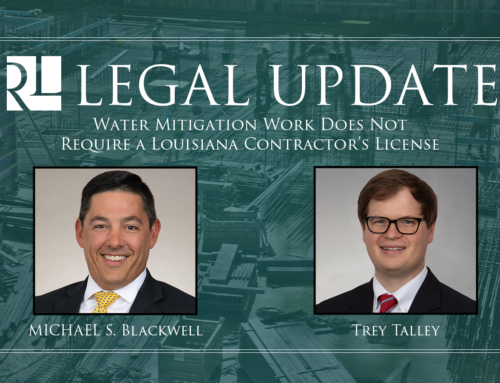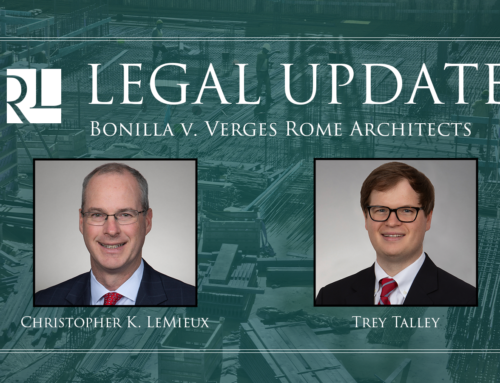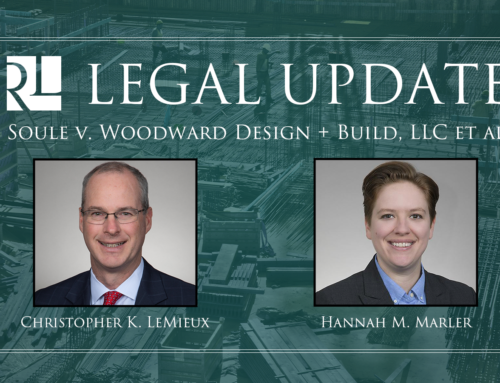 Bonilla v. Verges Rome Architects, 2022-0625 (La. App. 4 Cir. 5/11/23), 2023 WL 3371559.
Bonilla v. Verges Rome Architects, 2022-0625 (La. App. 4 Cir. 5/11/23), 2023 WL 3371559.
“Contractual Duties and Construction Site Safety – Court determines Architect’s awareness Creates Question of Fact as to the Duty Owed to Injured Worker.”
The plaintiff, Gustavo Bonilla sustained injuries while working as a subcontractor on a construction renovation project for The City of New Orleans (the “City”). The City contracted with a general contractor who subcontracted with Mr. Bonilla’s employer, Meza Services, to perform demolition services. Verges Rome Architects (“VRA”) was hired for designed and construction administration on the project, who then hired Morphy Makofsky, Inc. (“MMI”) to provide engineering services.
During the project, Mr. Bonilla was instructed to demolish a vault on the second floor. After he had partially demolished one of the walls, he was instructed to stand on top of the vault’s concrete ceiling to continue the demolition. The entire vault collapsed, and Mr. Bonilla sustained injuries. Mr. Bonilla filed suit against VRA and MMI, alleging negligence in the design plans, failure to provide support for the area being demolished, and failure to supervise the execution of the plans for safety. Both VRA and MMI filed motions for summary judgment, arguing that they did not owe a duty to oversee, supervise, or maintain the construction site or Mr. Bonilla’s safety based on the relevant contracts. The trial court granted summary judgment in favor of VRA and MMI and Mr. Bonilla appealed.
The issue on appeal was whether the relevant contract provisions imposed a duty on either VRA or MMI. “In determining the duty owed to an employee of a contractor by an engineering firm also involved in the project, the court must consider the express provisions of the contract between the parties.” Young v. Hard Rock Constr., L.L.C., 19-0484, p. 7 (La. App. 5 Cir. 3/17/20), 292 So. 3d 178, 184.
The Court analyzed the relevant contracts and considered photographs taken by Mr. Taffaro, an architect for VRA on the day of the accident, which indicated deviations from the contract requirements. The photographs showed Mr. Bonilla standing on scaffolding, inside the vault with his hand on the roof and no temporary supports or bracing as were required by the contract. Further, large rubble shown on the floor of the vault indicated the use of a different method of demolition than specified in the contract i.e. jackhammering and not saw cuts. Mr. Taffaro denied witnessing any unsafe conditions but Plaintiff’s expert testified that it should have been apparent to even a layman that removing walls without providing support would make the ceiling unstable.
The Court acknowledged the contractor was contractually responsible for the means and methods of construction and worksite safety. VRA’s contractual duties included making site visits to ensure the work was performed according to the design plans and to report any deviations from the plans.
The Court found genuine issues of material fact as to whether VRA owed a duty to Mr. Bonilla and issues of fact regarding VRA’s awareness of deviations from the contract and whether VRA failed to identify and report an unsafe condition. The Court reversed the judgment in favor of VRA and remanded the case for further proceedings.
Importantly, this case highlights that even though the contractual obligations and duty for worksite safety may primarily rest with the contractor, a duty can potentially be imposed on a design professional or Architect if they possess knowledge or awareness of a hazardous condition, regardless of their limited contractual responsibilities.



